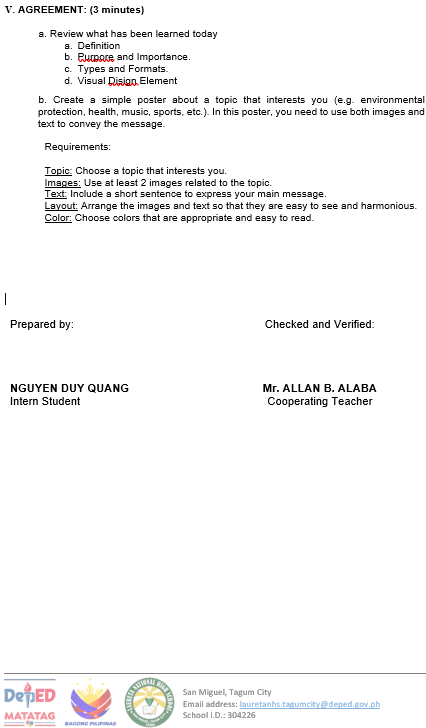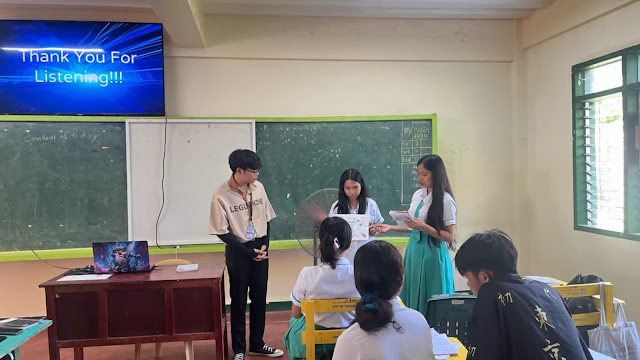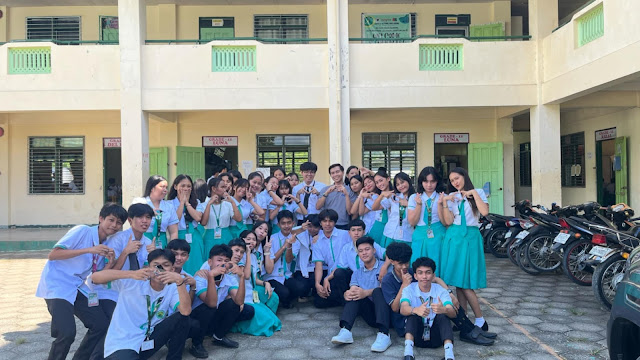SeaTeacher Program
Curriculum
A. Operational
Skills in Processing and Communicating Text Information:
Text Analysis Activities: Students practice reading comprehension and text analysis through ICT materials like technical reports, user manuals, and market research studies. They learn to identify text structure, specialized ICT vocabulary, and ways to organize information in digital documents.
Digital Text Writing Skills: Students are guided to write digital content, including emails, presentation documents, and reports. These exercises help students improve their ability to communicate and present textual information accurately, concisely, and clearly within ICT contexts.
Skills in Processing and Communicating Visual Information:
Visual Information Analysis: Students learn to analyze various types of visual information such as charts, diagrams, infographics, and social media images. They understand how to interpret information from visuals and how images can complement and add meaning to text.
Creating Visual Content: Students practice creating visual documents using tools like Canva, Photoshop, or PowerPoint. These activities enhance basic design skills, including selecting appropriate images and colors to convey information effectively.
B. Advocacy
Awareness of Digital Media and Digital Ethics:
Media Literacy: Students learn how different forms of media influence people’s perceptions, including social media platforms, advertising, and news outlets. They learn to evaluate information sources, verify content, and understand digital ethics principles.
Critical Thinking on Media Issues: Students participate in discussions on social issues related to digital media, such as fake news, data privacy, and personal security. These activities foster critical thinking and the ability to analyze information from multiple sources.
C. Campaign
Project-Based Learning Using Text, Visuals, and Multimedia:
- Multimedia Communication Project: Students work on multimedia projects like creating short videos, infographics, or online presentations. These projects help students apply their knowledge of text and visuals in real-world situations and develop teamwork skills.
Engaging in Digital Community Campaigns:
- Community Media Activities: Students participate in community-related media campaigns, such as awareness campaigns for environmental protection, information security, or hosting digital literacy workshops. These activities encourage students to use ICT skills to make a positive impact in their communities and build social communication skills.
Teaching plan
Teaching Practice
The first meeting at Laureta School
The first meeting at Laureta School was filled with excitement and anticipation. The school’s atmosphere was inviting, with colorful decorations and comfortable seating that put everyone at ease. Teachers introduced themselves and shared a bit about the upcoming school year, sparking curiosity and enthusiasm among the students. As everyone exchanged introductions, laughter and conversations filled the air, marking the beginning of new friendships and memorable experiences. The meeting ended with a feeling of unity and eagerness for the journey ahead.

The First meeting

Procedures of Teaching
Clear Learning Objectives: The ICT curriculum focuses on specific skills to develop students' abilities in understanding, creating, and critically evaluating text and visual media. Objectives include building foundational skills in vocabulary, syntax, design principles, analysis, and digital literacy.
- Example: For a lesson on text information, I set a clear goal: "Today, we will learn terms related to text and media formats and apply them in digital projects." This objective defines how students will engage with concepts through exercises on identifying, analyzing, and presenting information, making these goals clear and measurable.
Theory and Practice: Lessons combine theory with practice, using textbooks, digital media, and interactive tools such as video tutorials and infographics. This approach ensures students not only learn the theoretical aspects but also apply their knowledge in real-world scenarios.
- Example: For a hands-on lesson on visual information, students learn about design elements like color theory and layout. They practice using software to create simple graphics, allowing them to observe how their choices affect the visual message, making concepts like "visual hierarchy" more meaningful.
Group Activities and Discussion: Group activities encourage communication, cooperation, and critical thinking. Students work together to evaluate and create digital information, which enhances their understanding through peer collaboration.
- Example: In a group activity on creating an infographic, I set the objective, "Design an engaging infographic that communicates a learned concept." This activity allows students to discuss and decide on visual elements as a team, showing their understanding of how design principles enhance communication.
Time Management and Activity Organization: The lesson structure is well-defined with specific time allocations for each activity, ensuring smooth transitions and maximizing student engagement.
Preliminary Activity: Motivation (3-5 minutes)
Development Activity:
- Introduction (5 minutes): Introducing the topic or tool
- Analysis (10 minutes): Group discussion or media analysis
- Abstract (5 minutes): Synthesizing key points
- Application (10 minutes): Hands-on practice with text or visual tools
- Generalization (5 minutes): Reflecting on the learning process
Wrap-up Exercises (3-5 minutes)
Example: In a lesson on analyzing visual information, I allocate time for introducing media, group discussions, and hands-on practice with editing software. If students have questions, I use extra time to clarify concepts, ensuring everyone understands the role of visual elements in media.
Classroom Commitments: Clear expectations promote a positive learning environment. These include:
Respect: Value classmates' contributions.
Participation: Actively engage in all activities and discussions.
Collaboration: Work effectively in groups, ensuring every voice is heard.
Responsibility: Complete assignments on time and come prepared.
Example: I set classroom norms like "Listen while others speak" to foster respect. These commitments help create a collaborative atmosphere, allowing me to observe and measure student engagement effectively.
Problem-Solving Commitment: Emphasizing open communication and flexibility in activities underscores the importance of solving challenges in ICT projects.
Open Communication: Encourage students to express concerns or questions during discussions.
Support: Offer assistance to peers struggling with concepts or tasks.
Adaptability: Stay flexible and ready to adjust approaches to ensure all students engage meaningfully.
Example: During a media editing project, some students struggled with specific software features. I provided extra tutorials for those who needed help, while offering advanced resources for students who progressed quickly. This differentiation supports a learning environment where students can succeed based on their individual needs.
Additional Aspects:
Feedback and Reflection: After each lesson, I collect student feedback on what worked well and areas to improve, fostering a culture of continuous growth.
Cultural Relevance: Include locally relevant topics in media projects to make learning more relatable and meaningful.
Professional Development: Attend workshops and collaborate with colleagues to stay current on ICT teaching strategies and best practices.
Example: My involvement in a student tech club lets me support students in developing digital skills beyond the classroom. This experience allows me to establish clear language expectations and support systems, making students’ progress measurable and actionable.
This comprehensive curriculum on "Text Information and Visual Information and Media" in ICT builds students' digital and critical thinking skills, creativity, and adaptability. It prepares students to apply ICT concepts practically while fostering a collaborative and engaging learning environment.


Summary and Suggestions
Purposes of practicum
Procedures of practicum
The SEA-Teacher Program is structured into four essential steps, each providing valuable experience for aspiring teachers:
Observation: Participants begin by observing classroom dynamics, student abilities, and learning styles. This helps ICT teachers understand student engagement and adapt future lessons to suit their learning pace and background knowledge.
Teaching Assistantship: Acting as a teaching assistant allows participants to interact closely with students, providing hands-on support while also refining classroom management skills and identifying effective teaching strategies for ICT concepts.
Practice Teaching: Participants lead classes, delivering lessons independently. For ICT teachers, this stage provides real-world experience in teaching technical topics and adjusting explanations for different comprehension levels.
Evaluation and Reflection: Finally, participants engage in self-reflection and receive feedback, helping them identify areas for improvement and enhance their teaching approach for ICT subjects.
Challenges of practicum
Language Barrier
- Challenge: Language differences were a major obstacle, as participants often struggled with effective English communication, especially with academic vocabulary. This limited their ability to fully understand some topics.
- Suggestions:
- Schools could introduce English-taught classes in specific subjects, allowing students to build academic vocabulary in context.
- Organizing English competitions in different fields could encourage students to strengthen their language skills.
- Overall: Improving English proficiency is essential for both students and program participants.
Cultural Differences
- Challenge: Cultural differences, such as driving and walking norms, posed adjustment challenges. Adapting to these required an awareness of local practices.
- Suggestion: SEAMEO could hold pre-program meetings to brief participants on the culture of their host country, helping them prepare for these differences.
Overall impression
The SEA-Teacher Program provided me with the opportunity not only to study abroad but also to explore, experience, and immerse myself in diverse cultures across the region. Alongside enhancing my language skills and communication abilities, the program helped me build confidence in teaching and interacting in an international environment. Overall, this was an incredibly valuable hands-on experience that deepened my understanding of the teaching profession and the real-world demands and challenges it presents.
The program was not just a learning journey but also a chance for my comprehensive personal and professional growth. I was able to apply the knowledge and skills I had acquired in practical teaching within a professional educational environment, with the support of experienced colleagues and mentors. Participating in SEA-Teacher broadened my perspective, allowing me to understand more fully the role of education in connecting and developing communities.















Nhận xét
Đăng nhận xét